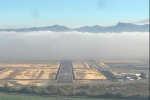MauleSkinner
Touchdown! Greaser!
Same reason some pilots won’t accept SVFR in the daytime without being instrument rated/equipped…belt and suspenders/security blanket.OK, but why would the pilot request it if he didn't need it?
agreed. But personally, if I was transiting, I’d just go around the surface area rather than go through the hassle of dealing with ATC. So I’d ask the same question…why would someone transit controlled airspace when SVFR would be required?So the difference seems to be the regulation you cite provides this exception for aircraft that are taking off or landing. This implies that VFR aircraft transiting the class D airspace without taking off or landing would need the standard VFR cloud clearances, or an SVFR clearance.
Last edited:

 This airport didn't require SVFR but AWOS was reporting low visibility (I don't remember exactly what). A go around may have been iffy.
This airport didn't require SVFR but AWOS was reporting low visibility (I don't remember exactly what). A go around may have been iffy.